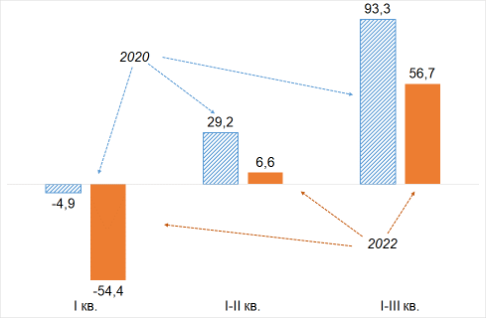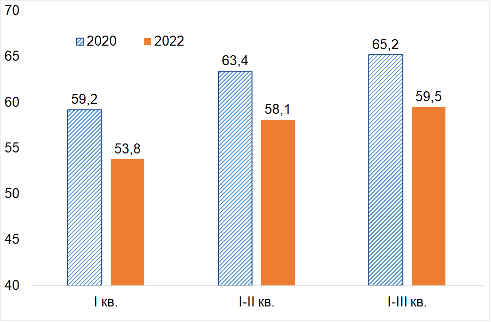With the beginning of the Russian aggression, the State Statistics Service practically stopped providing official statistical reports, which was quite justified, including for social and psychological reasons. Of course, the State Statistics Service continued to collect information, and the role of statistical indicators was "performed" by the surveys periodically conducted by the State Statistics Service and the NBU. To be sure, polls cannot replace official statistics (although the latter is subject to criticism), but for some time they could act as a reference point for the development of certain economic sectors.
Finally, at the end of 2022 the State Statistics Service began to publish reports whose publication deadline was missed due to martial law – and the first reports revealed quite unexpected features of the national economy in 2022. Let us pay attention to the financial results of economic activity of companies.
(1). Quite expectedly, the revenues of large and medium-sized enterprises before taxes in 2022 suffered substantial losses, but how significant were they, compared to the previous years?
Noteworthy, comparing the results of 2022 (wartime) with the previous (peaceful) year of 2021 does not seem correct. The "best" reporting years for comparison with 2022 are 2015 (Russia's first aggression against Ukraine, GDP drop by 9.8%) and 2020 (mass bans, restrictions and losses due to the coronavirus pandemic, GDP drop by 3.8%), both of these periods are also characterized by significant socio-economic losses (although the nature of those losses was different).
Here we will compare the financial results of 2022 with the "closer" year of 2020, when the coronavirus restrictions were imposed on enterprises throughout the country – of course, it should be adjusted for the fact that the circle of enterprises covered by statistics in 2022 significantly differed from 2020 (due to the loss of territories, destruction and ruination of the economic structure and infrastructure, etc.).
Hence, evaluating the data of official statistics, we get something unexpected. First, it turns out that even in wartime, domestic enterprises obtain profit (here we will not discuss here how much this correlates with the "real" state of affairs, since even in peacetime official indicators were open to doubt). Yet, the dynamics of profit/losses both in 2020 and 2022 follow the same trend: from negative values in the 1st quarter to positive ones in the last three quarters of the year. Moreover, the total "net" profit of enterprises over the three quarters of 2022 is only marginally lower than the corresponding value of 2020 (UAH 56.7 billion against UAH 93.3 billion, i.e. the difference is less than UAH 40 billion) (chart "Financial results...profit/losses")
Secondly, the share of enterprises that made profit in 2022 was only marginally less than their share in 2020. Moreover, this share for the three quarters of 2022 reached almost 60% of all enterprises (diagram "Financial results...share of profit-making companies"). There are reasons to state that many domestic enterprises managed to maintain activities, generally keep their staff, update logistics chains and find markets.
Financial results of large and medium-sized enterprises before taxation
Profit/losses, billion UAH

1st quarter 1st-2nd quarter 1st-3rd quarter
Share of profit-making companies, %

1st quarter 1st-2nd quarter 1st-3rd quarter
(2). A certain "check" of the correctness of the provided statistical information about the profitability of companies in 2022 may be performed, using the results of surveys. It makes sense to correlate official statistics with the results of surveys among companies, especially those made at the end of a quarter (since in this period the company managers know the state of affairs at their enterprise and the economic results achieved in the relevant quarter).
So, the NBU conducts monthly surveys of enterprises regarding their business expectations, determining the so-called economic sentiment index (ESI). In the reporting year until September 2022, the survey revealed that business was adapting to wartime conditions, gradually recovering (despite the destruction of capacities, rising energy prices, a decrease in purchasing power, etc.). Therefore, the business softened its negative expectations of the previous months, and in September ESI increased, reaching the highest (except for one month) level in 2022 – 46.1. Such a conclusion fully correlated with the statistical financial results.
What can this index give us for the assessment of further financial results, in particular, in the 4th quarter of 2022? (remember about the "late" statistical reporting in this respect by a quarter even in peacetime).
The December polls and ESI give us an idea. Given the intensification of bombings (new destructions and a sharp increase in electricity shortages) in November-December, business activity weakened in the short run – the ESI fell to 42.1 (in November - 42.7). This is caused not only by the current escalation of bombings but also by negative expectations of their continuation and intensification, which, in turn, means a decrease in the production of goods (services), new orders, etc.
Therefore, there are reasons to claim that the mentioned key factors (bombing and electricity shortage) will lead to additional economic losses for Ukraine, and thus to deterioration of the company performance in the 4th quarter of 2022. Moreover, the losses of the last quarter may surpass the positive results of the previous three quarters, which will mean a decrease in the share of profitable companies and overall unprofitability of economic activity in 2022.
However, this conclusion is not unquestionable. As an alternative to this scenario of falling profitability, we may even see an improvement in profitability indicators along with a sharp increase in imports of power generation equipment, which will once again confirm that domestic business has the proper experience and demonstrates a high level of adaptation and sustainability even in extreme conditions.
https://razumkov.org.ua/komentari/pro-porivniannia-finansovykh-rezultativ-diialnosti-pidpryiemstv




